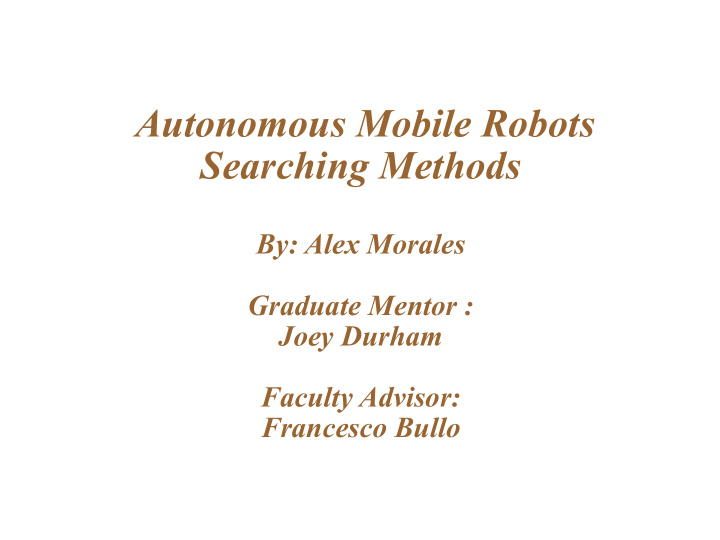



Autonomous Mobile Robots Searching Methods By: Alex Morales Graduate Mentor : Joey Durham Faculty Advisor: Francesco Bullo
Better Algorithms Design algorithms for better multi-robot coordination Design a Search Algorithms for robots Better understand robot – surrounding − interaction
Autonomous Robots ● What are autonomous robots? ● Why should we study them? ● How will they help us? Google images
Applications Make human life easier – Perform common tasks, help the handicapped Search and rescue robos Google images
Project Goals Build a foundation for searching algorithms for autonomous robots Create an efficient algorithm to search for an object in a known map. – Minimize time
Project Goals Target object Static Environment Obstacle/Wall Robot
Project Goals Target object Static Environment Obstacle/Wall Robots
Project Goals Target object Static Environment Obstacle/Wall Robots
Project Goals Target object Unknown Static Environment Robot
Project Goals Target object = ? Unknown Environment Robots
Equipment: Robot hardware Stereo Vision Camera On board computer Laser range- finder Joey Durham
Player/Stage Interface Is a open source software that enables us to do research. Player is a network server for robot controls Stage simulates mobile robots in 2-D. Advantages vs "All the world's a stage, And all the men Disadvantages and women merely players." - William Shakespeare, As You Like It Joey Durham
Searching Algorithm Receive laser data Check if Main part of algorithm object was found – Design, Test, Refine Create frontier Decide next move Object found finish.
Design • Check for Frontier • Visibility of the robot • Polygons • Save polygons instead of having to save every point of the frontier
Determining how to move ● Default left ● Decision based on Frontier
Result so far ...
Result so far ...
Result so far ...
Result so far ...
Result so far ...
Exploration Graph • Map of the Robot • Graph of nodes/positions of robots
Conclusion • Field of Vision of Robot ● Visible polygon • Decision making part of algorithm • Based on how frontier/boundary are created and stored – Intersections merge frontier arcs. ● Navigate through map with an exploration graph.
Acknowledgements ● Mentor Joey Durham ● Dr. Francesco Bullo ● Ofelia Aguirre ● Eric Pressly ● CNSI ● NSF ● SIMS and EPSEM programs
Multiple Robots Object 2
Laser Rangefinder ● Model: Hokuyo URG ● Wavelength: 785 nm ● Range: 4 meters ● Scan rate: 10 Hz ● Resolution: 0.36 degrees ● Price: $2500 Source: http://www.videredesign.com/robots/era_mobi.html
Robot Chassis ● Model: Videre ERA-MOBI ● Size: cm(L) x 37cm (W) x 18 cm(H) ● Batteries: 3x 12V 7 Amp-Hour (4-5 Hours) ● Encoder accuracy: 500 counts/rev ● Speed: Up to 2.0 m/s ● Capacity: 20 kg (44 lbs) ● Price: $2350 Source: http://www.videredesign.com/robots/era_mobi.html
Conclusion Object 1
Recommend
More recommend